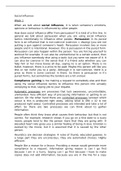Samenvatting
Extensive summary of the course social influence
- Vak
- Instelling
Extensive summary of the course of social influence. Covers all of the important subjects you need to get a great grade on your exam. I used this myself for the exam and got a 9 :)
[Meer zien]



